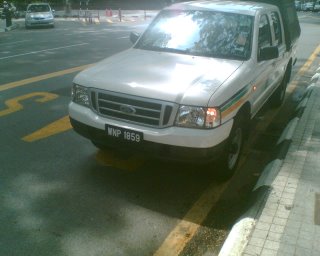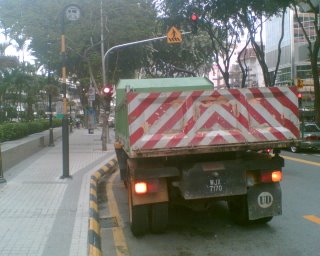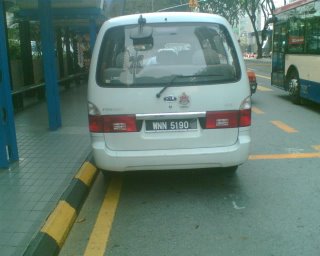Sorry for the long period of silence.
I have been pretty busy so I haven't have had much time to think and research about public transportation. So even today's post will be abit substanceless and maybe not directly related to public transportation, although they are still IMPORTANT issues.
Stationary violationThis was frontpaged in the Star today:

Can you tell me what is wrong in this photo?
See that row of cars parked by the sides? Well that's an emergency lane on a highway. And there's this row of cars, probably driven by the press and the Police. They have themselves committed a traffic offence and have endangered other road users.
The law states it clearly: emergency lanes are for of emergency vehicles and for breakdowns. Even then, it has to be towed away ASAP. If I am not mistaken motorcycles are also allowed to use it.
Regarding the problem then of how and where the journalists were to park, that is not my problem. Reporting a story on road safety doesn't give anyone the license to break the law themselves.
Dewan Bandaraya Kuala Lumpur
Remember the
photos sent in by Loke W? Well I submitted it to the Star. I hope the mayor who hasn't been reading his emails reads this today.
Being an officer of the law DOES NOT give you the license to break the law yourself.
VigilanteismIt's the season once again when the politikus start rambling in the newspapers about crime and "illegal immigrants".
As usual, according to these people, every Indonesian, Burmese and Bangladeshi is a suspect. And they should be sent home (all though no one has thought who is going to replace them, especially the illegals to work in the plantations, factories, restaurants, construction sites etc. that would be Malaysian Idle. You think Malaysians want to do this kind of work?).
And of course,
Rela, the citizen vigilante group, is given the carte blanche to arrest some Burmese, beat them up and throw them into a pond.

So in the spirit of this season of fear, I encourage you to spy on your fellow citizens for a better cause.
Remember, only use cameras when it is safe. Never when you are the driver (even when you are stationary).
Take photos of all those buggers hogging bus lanes. People cutting in and out. People littering from the car window. People who park in two boxes. People who park in front of fire hydrants.
This beats the hell out of beating people and throwing them into ponds. And even though you are "snitching" and telling on other people, why worry? The Star will black out number plates. And JPJ - what action?
But at any rate, I would still encourage you to submit these photos, with as much information to these people.
- panducermat.org.my/gallery - registration required
- thumbnails@thestar.com.my
- kpjpj@jpj.gov.my
And now the fun partEver dreamt of being a police officer as a kid!? Well dream no more.
While you're at it, issue a "saman" for the traffic offender. I think it will be quite difficult in most cases to issue it, with the exception of parking offences. Still, it's better than nothing!
In classic ugly formatting and Times New Roman and in A4 size this is almost as real as it can get.

Print this out. Plenty of it. Keep it in your car/bag. Issue it liberally, but please children, don't ask for a bribe.
And remember, don't be a HYPOCRITE like DBKL, The Star and the Police.




















